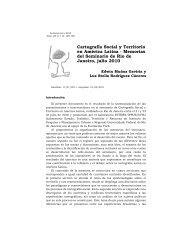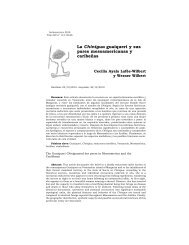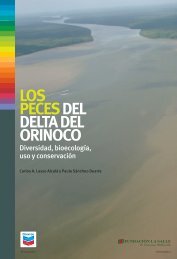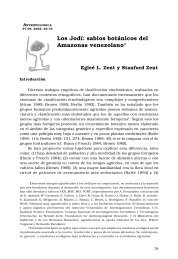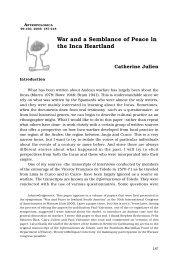El abandono de un ecosistema: el caso de los Morichales del Delta ...
El abandono de un ecosistema: el caso de los Morichales del Delta ...
El abandono de un ecosistema: el caso de los Morichales del Delta ...
Create successful ePaper yourself
Turn your PDF publications into a flip-book with our unique Google optimized e-Paper software.
change and specific ecosystems are partially or totally r<strong>el</strong>inquished. Such<br />
is the case of the Warao of the central Orinoco D<strong>el</strong>ta and their exploitation<br />
of the moriche palm forest.<br />
For many centuries, the Warao Indians have exploited the extensive<br />
groves of the moriche palm (Mauritia flexuosa) of the Orinoco D<strong>el</strong>ta in<br />
northeastern Venezu<strong>el</strong>a, which furnished the traditional staple food<br />
“yuruma,” ohidu aru, a type of sago not <strong>un</strong>like the one produced in Oceania<br />
from the Metroxylon palms (Metroxylon spp.). Not only has this palm a great<br />
number of food items associated with it but it furnishes a number of useful<br />
materials, especially fibers from which the traditional Warao hammock is<br />
fashioned.<br />
The moriche complex was firmly anchored in Warao r<strong>el</strong>igion and ritual.<br />
Prominent in the yearly cycle was the naha namu or sago ritual which took<br />
forms adapted to the ecological conditions of each of the two major zones<br />
of the lower D<strong>el</strong>ta, the central D<strong>el</strong>ta with its endoreic (non-f<strong>un</strong>ctional)<br />
distributaries and the south-eastern D<strong>el</strong>ta with a number of major fastflowing<br />
distributaries which have prono<strong>un</strong>ced levees and moriche palms<br />
c<strong>los</strong>e to the river banks.<br />
With the introduction in the 1920s from the Guayanas of an easy to<br />
plant tuber, ure or “ocumo chino” (Colocasia sp.), large groups of Warao<br />
started to move out of the moriche palm swamps of the central D<strong>el</strong>ta and<br />
into the open rivers, where they now combine fishing and incipient agriculture<br />
with wage labor. Exploitation of the moriche ecosystem is now confined to<br />
occasional forays.<br />
The new habitat of the Warao, however, is not nearly as complete as<br />
the palm groves once were. The Warao increasingly move out of the D<strong>el</strong>ta<br />
altogether and settle in the vicinity of urban centers. The present paper<br />
attempts a comprehensive <strong>de</strong>scription of the morichal ecosystem and its<br />
traditional utilization by the Warao. An outline is given of the processes that<br />
lead to the abandonment of this rich and varied environment.<br />
Resumen<br />
Culturas a escala pequeña generalmente explotan <strong>ecosistema</strong>s bien<br />
<strong>de</strong>finidos. Cuando ocurren procesos <strong>de</strong> aculturación, pue<strong>de</strong>n tener lugar<br />
cambios en la utilización <strong>de</strong> tales <strong>ecosistema</strong>s, y éstos quedar parcial o<br />
totalmente abandonados. Tal es <strong>el</strong> <strong>caso</strong> <strong>de</strong> <strong>los</strong> Warao <strong>de</strong>l D<strong>el</strong>ta central en<br />
r<strong>el</strong>ación al <strong>ecosistema</strong> morichalero.<br />
Por muchos sig<strong>los</strong> <strong>los</strong> indígenas Warao han explotado las vastas<br />
extensiones <strong>de</strong> la palma <strong>de</strong> moriche (Mauritia flexuosa), <strong>los</strong> llamados<br />
morichales. Allí conseguían la comida básica tradicional, la “yuruma,”<br />
ohidu aru, <strong>un</strong> tipo <strong>de</strong> sagú parecido al <strong>de</strong> la cuenca <strong>de</strong>l Pacífico, don<strong>de</strong> se<br />
procesa la palma Metroxylon (Metroxylon spp.). La palma <strong>de</strong> moriche no<br />
sólo produce gran cantidad <strong>de</strong> comestibles aparte <strong>de</strong> la yuruma tales como<br />
29



